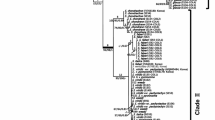Abstract
To address systematic issues pertaining to series Pilosa of Korean Chrysosplenium, the phylogenetic relationships of the 35 accessions of Korean Chrysosplenium taxa were examined using the DNA sequence data obtained from the nuclear ribosomal internal transcribed spacer (ITS) regions and the psbK-I gene of the plastid genome. The results from both ITS and psbK-I sequence data indicated that Chrysosplenium flaviflorum formed a well-supported clade that merits species status of the taxon. The ITS phylogenetic trees detected two distinct lineages in Chrysosplenium pilosum var. fulvum. Geographically, one lineage was widely distributed throughout the country whereas the other was confined to Gyeonggi and Gangwon provinces. The plants sampled from Jeju Island, which have been recognized as C. pilosum var. sphaerospermum [C. hallaisanense] exhibited no DNA sequence feature segregating them from C. pilosum var. fulvum [C. barbatum] distributed in the mainland area of Korea. The plastid DNA sequence data was not fully in concordance with the nuclear ribosomal ITS data and the current taxa delimitation. These results suggest incomplete lineage sorting or that plastid genome capture may have occurred during the evolution of some taxa examined in the present study.


Similar content being viewed by others
References
Álvarez I, Wendel JF (2003) Ribosomal ITS sequences and plant phylogenetic inference. Mol Phylogenet Evol 29:417–434
Chung YH, Kim YD (1988) Monographic study of the endemic plants in Korea X. Taxonomy and interspecific relationship of the Genus Chrysosplenium. Korea J Environ Biol 6:33–63
Feliner GN, Rosselló JA (2007) Better the devil you know? Guidelines for insightful utilization of nrDNA ITS in species-level evolutionary studies in plants. Mol Phylogenet Evol 44:911–919
Felsenstein J (1985) Confidence limits on phylogenies: an approach using bootstrap. Evolution 39:783–791
Hara H (1957) Synopsis of genus Chrysosplenium L. (Saxifragaceae). J Fac Sci Univ Tokyo Bot 7:1–90
Kim YD (2007) Chrysosplenium L. In: Park CW (ed) The genera of vascular plants of Korea. Academy Publishing, Seoul, pp 528–530
Nakazawa M, Michio W, Mikio O, Jin M (1997) Molecular phylogenetic analysis of Chrysosplenium (Saxifragaceae) in Japan. J Plant Res 110:265–274
Nei M (1987) Molecular evolutionary genetics. Columbia University Press, New York
Ohwi J (1934) Plantae Novae Japonicae. Repert Spec Nov Regni Veg Beih 36:50–55
Ohwi J (1937) Symbolae ad Floram Asiae Orientalis 15. Acta Phytotax Geobot 6:145–153
Posada D, Crandall KA (1998) Modeltest: testing the model of DNA substitution. Bioinformatics 14:817–818
Rannala B, Yang Z (1996) Probability distribution of molecular evolutionary trees: a new method of phylogenetic inference. J Mol Evol 43:304–311
Rieseberg LH, Brunsfeld SJ (1992) Molecular evidence and plant introgression. In: Soltis PS, Soltis DE, Doyle JJ (eds) Molecular systematics of plants. Chapman and Hall, New York, pp 151–176
Rieseberg LH, Soltis DE (1991) Phylogenetic consequences of cytoplasmic gene flow in plants. Evol Trends Pl 5:65–84
Ronquist FR, Huelsenbeck JP (2003) MRBAYES 3: Bayesian phylogenetic inference under mixed models. Bioinformatics 19:1572–1574
Soltis DE, Soltis PS, Collier TG, Edgerton ML (1991) Chloroplast DNA variation within and among genera of the Heuchera group (Saxifragaceae): evidence for chloroplast transfer and paraphyly. Amer J Bot 78:1091–1112
Soltis DE, Kuzoff RK, Conti E, Gornall R, Ferguson K (1996) MatK and rbcL gene sequence data indicate that Saxifraga (Saxifragaceae) is polyphyletic. Amer J Bot 83:371–382
Soltis DE, Nakazawa MT, Xiang QY, Kawano S, Murata J, Wakabayashi M, Jetter CH (2001) Phylogenetic relationships and evolution in Chrysosplenium (Saxifragaceae) based on matK sequence data. Amer J Bot 88:883–893
Swofford DL (2002) PAUP* Phylogenetic analysis using parsimony (* and other method), ver. 4.0b10. Sinauer Associates, Sunderland
Thompson JD, Gibson TJ, Plewniak F, Jeanmougin F, Higgins DG (1997) The Clustal X windows interface: flexible strategies for multiple sequence alignment aided by quality analysis tools. Nucleic Acids Res 24:4876–4882
Wendel JF, Doyle JJ (1998) Phylogenetic incongruence: window into genome history and molecular evolution. In: Soltis PS, Soltis DE, Doyle JJ (eds) Molecular systematics of plants II: DNA sequencing. Kluwer, Dordrecht, pp 265–296
White TJ, Bruns T, Lee S, Taylor JW (1990) Amplification and direct sequencing of fungal ribosomal RNA genes for phylogenetics. In: Innis MA, Gelfand DH, Sninsky JJ, White TJ (eds) PCR protocols: a guide to methods and applications. Academic, San Diego, pp 315–322
Acknowledgments
This research was supported by Hallym University Research Fund (HRF-2010-021) and the Flora of Korea project (Eco-Technopia 21 project on environmental technology development 052-081-070).
Author information
Authors and Affiliations
Corresponding author
Rights and permissions
About this article
Cite this article
Kim, YI., Kim, YD. Molecular Systematic Study of Chrysosplenium Series Pilosa (Saxifragaceae) in Korea. J. Plant Biol. 54, 396–401 (2011). https://doi.org/10.1007/s12374-011-9175-6
Received:
Revised:
Accepted:
Published:
Issue Date:
DOI: https://doi.org/10.1007/s12374-011-9175-6




